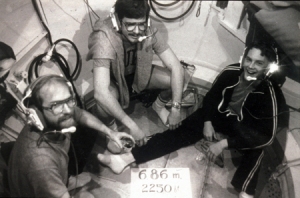
Clarke JR1, Moon RE2, Chimiak JM3, Stinton R4, Van Hoesen KB5, and Lang MA5,6.
1 US Navy Experimental Diving Unit, Panama City, Florida
2 Duke University, Durham, North Carolina
3 Divers Alert Network, Durham, North Carolina
4 Diving Unlimited International, Inc., San Diego, California
5 UC San Diego – Emergency Medicine, San Diego, California
6 OxyHeal Health Group, National City, California
Introduction
The San Diego Center of Excellence in Diving at UC San Diego aims to help divers be effective consumers of scientific information through its “Healthy Divers in Healthy Oceans” mission. In this monograph we explore a research report from the Navy Experimental Diving Unit (NEDU) that is leading some divers to think they should be cold if they want to reduce decompression risk. That is a misinterpretation of the report, and may be causing divers to miss some of the joy of diving. There is no substitute for comfort and safety on a dive.
Background
In 2007 NEDU published their often-cited report “The Influence of Thermal Exposure on Diver Susceptibility to Decompression Sickness” (Gerth et al., 2007). The authors, Drs. Wayne Gerth, Victor Ruterbusch, and Ed Long were questioning the conventional wisdom that cold at depth increases the risk of decompression illness. After conducting a very carefully designed experiment, they were shocked to find that exactly the opposite was true. Some degree of cooling was beneficial, as long as the diver was warm during ascent.
Discussion and Implications
There are some important caveats for the non-Navy diver to consider. First of all, it was anticipated that a diver would have a system for carefully controlling their temperature during the separate phases of bottom time and decompression. Most non-Navy divers do not have that sort of surface support.
Secondly, the “cold” water in the NEDU study was 80 °F (27 °C). For most of us, 80 °F (27 °C) is an ideal swimming pool temperature, not exactly what you are going to find in non-tropical oceans and lakes. The warm water was 97 °F (36 °C), also a temperature not likely to be available to recreational and technical divers.
When testing the effect of anything on decompression results, the Navy uses their extensive mathematical expertise to select the one dive profile that is, in their estimation, the most likely to identify a difference in decompression risk, if that difference in risk exists. In this case the profile selected was a 120 fsw (37 msw) dive with 25 to 70 min bottom time, decompressed on a US Navy Standard Air table for 120 fsw (37 msw) and 70 min bottom time. That table prescribes 91 minutes of decompression divided thusly: 30 fsw/9 min (9msw/9 min), 20 fsw/23 min (6 msw/23 min), 10 fsw/55 min (3 msw/55 min).
A total of 400 carefully controlled dives were conducted yielding 21 diagnosed cases of decompression sickness. Overwhelmingly, the lowest risk of decompression was found when divers were kept warm during decompression. The effects of a 9 °C increase in water temperature during decompression was comparable to the effects of halving bottom time.
That is of course a remarkable result, apparently remarkable enough to cause civilian divers to alter their behavior when performing decompression dives. However, before you decide to chill yourself on the bottom or increase your risk of becoming hypothermic, consider these facts.
- Do you have a way of keeping yourself warm, for instance with a hot water suit, during decompression? If not, the study results do not apply to you.
- Of the many possible decompression schedules, the Navy tested only one schedule, the one considered to be the best for demonstrating a thermal influence on decompression risk. Although it seems reasonable that this result could be extrapolated to other dive profiles, such extrapolation is always risky. It may simply not hold for the particular dive you plan to make, especially if that dive is deeper and longer than tested.
- Most commercial decompression computers do not adhere to the U.S. Navy Air Tables; few recreational dives are square profiles. Furthermore, additional conservatism is usually added to commercial algorithms. NEDU is not able to test the effects of diver skin temperature on all proprietary decompression tables, nor should they. That is not their mission.
- The scientific method requires research to be replicated before test results can be proven or generalized. However, due to the labor and expense involved in the NEDU dive series, it seems unlikely that any experiments that would determine the relevance of these results to recreational or technical diving will ever be performed. As such, it may raise as many questions as it answers. For instance, the original question remains; if you become chilled on a dive, how does that affect your overall risk of decompression illness compared to remaining comfortably warm? Unfortunately, that question may never be answered fully.
- Thermoneutral temperatures for swim suited divers are reported to be 93 °F to 97 °F (34 to 36 °C) for divers at rest and 90 °F (32 °C) during light to moderate work (Sterba, 1993). So a skin temperature of 80 °F (27 °C) is indeed cold for long duration dives. If your skin temperature is less than 80 °F (27 °C), then you are venturing into the unknown; NEDU’s results may not apply.In summary, beer and some types of wine are best chilled. Arguably, divers are not.
Acknowledgments
Support for the San Diego Center of Excellence in Diving is provided by founding partners UC San Diego Health Sciences, UC San Diego Scripps Institution of Oceanography, OxyHeal Health Group, Divers Alert Network, Diving Unlimited International, Inc. and Scubapro.
References
Sterba JA. Thermal Problems: Prevention and Treatment, in P.B. Bennett and D.H. Elliot, eds., The Physiology and Medicine of Diving, 4th ed. (London: Saunders, 1993), pp. 301-341.



